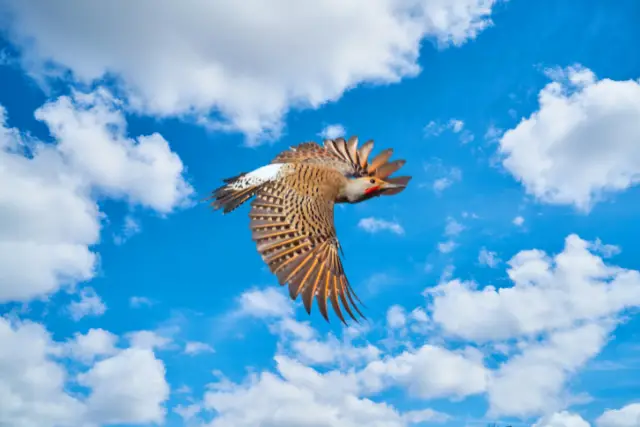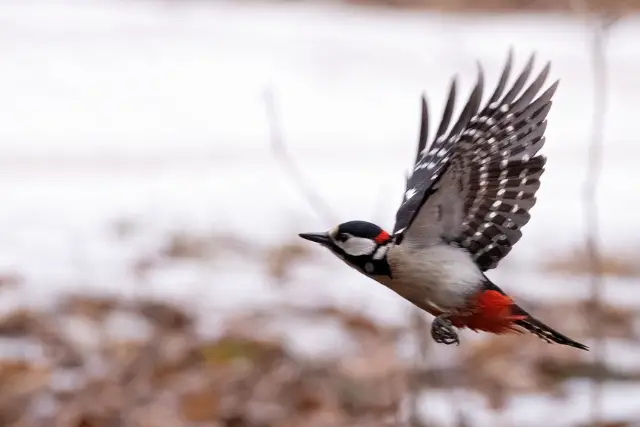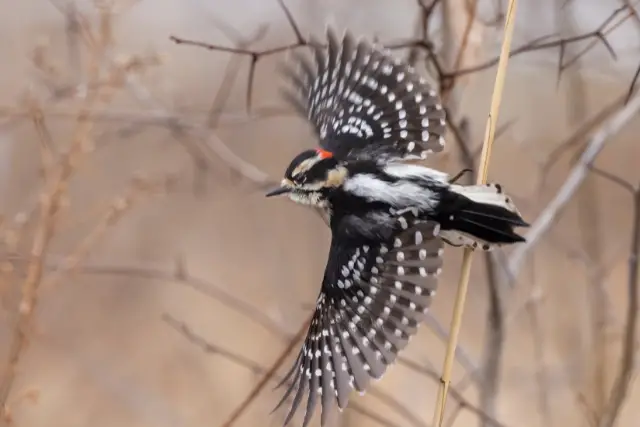Wondering if woodpeckers migrate? Yes, some woodpeckers do migrate, while others stay in the same area year-round. The behavior can depend on the species and where they live.
Certain woodpeckers in North America migrate south for winter, while others adapt to changing seasons without moving far. Their patterns are fascinating and closely tied to their habitats and food sources.
Key Takeaways
- Some woodpeckers migrate seasonally.
- Migration habits vary by species.
- Habitat and food influence woodpecker migration.
Woodpecker Migration

Woodpecker migration involves the seasonal movement of some woodpecker species. This happens mainly due to changes in food availability and temperature.
Definition and Basics of Migration
Migration is the movement of animals from one place to another. For woodpeckers, this can mean moving north in the summer and south in the winter. Some species like the Yellow-bellied Sapsucker are migratory woodpeckers. They migrate to find better food sources and avoid harsh weather.
Birds that migrate usually follow a flight pattern. This pattern helps them reach their destination using the best route. Not all woodpeckers migrate; some stay in the same area all year. Migratory behavior often depends on the species and the environment they live in.
Factors Influencing Woodpecker Migration
Several factors influence woodpecker migration, mainly food availability and temperature. Many woodpeckers feed on insects, which can be scarce in colder months. Warm weather locations provide abundant food sources.
Habitat changes also affect migration patterns. Deforestation and urbanization can force woodpeckers to migrate to find suitable living conditions. Diet plays a crucial role too; some woodpeckers may migrate to areas where their preferred food is more plentiful.
Temperature fluctuations make migration necessary for survival. In colder zones, woodpeckers migrate to avoid freezing conditions. This movement ensures they maintain access to food and favorable living conditions throughout the year.
Woodpecker Species and Their Migratory Patterns
Woodpeckers show a range of migratory behaviors. Some species migrate seasonally, while others remain in the same area all year.
Variation in Migration Across Species
Woodpecker migration varies widely. For example, the pileated woodpecker and red-bellied woodpecker are generally non-migratory, staying in their habitats year-round. Meanwhile, the yellow-bellied sapsucker and northern flicker migrate from northern regions to warmer southern areas to avoid cold winters.
These differences in migratory patterns depend on factors like climate, food availability, and breeding needs. Some woodpeckers, like the downy woodpecker, might move short distances, while others, like the red-headed woodpecker, can travel hundreds of miles.
Notable Migratory Woodpeckers
The yellow-bellied sapsucker is a well-known migratory species. It breeds in Canada and the northern U.S. and winters in the southern U.S. and Central America. Another notable migratory species is the northern flicker, which travels from northern regions to the southern U.S. and Mexico.
The Lewis’s woodpecker also shows migratory behavior, moving to lower elevations or southern areas during winter. These species travel to find food and suitable habitats, demonstrating the diversity in woodpecker migration.
Sedentary Woodpecker Species
Some woodpecker species are sedentary, meaning they do not migrate. The pileated woodpecker is a prime example, living in the same forested areas year-round. The red-bellied woodpecker and hairy woodpecker also tend to stay put, finding enough food and shelter in their habitats throughout the year.
The acorn woodpecker is another sedentary species. It stores acorns in tree cavities, ensuring a steady food supply and eliminating the need to migrate. These species have adapted to their environments, reducing the need for seasonal travel.
Geographical Aspects of Woodpecker Migration

Woodpeckers' migration patterns vary widely depending on their species and the regions they inhabit. They may travel within North America, including Canada, the United States, and parts of Central America.
Common Migration Routes
Woodpeckers in North America often follow established paths. These routes may stretch from Canada to Mexico. Some common routes include flying from the northeast to the southeast United States. Migrating woodpeckers may also travel along the coasts, including areas like California and Oregon.
Regional Migration Patterns
Regional differences shape how woodpeckers migrate. For instance, woodpeckers from Alaska might move south to Oregon or California. In the Midwest, woodpeckers may head to the warmer southeast United States. Those from Canada often migrate to Central America, avoiding the harsh northern winters.
These movements ensure they find suitable habitats year-round.
Environmental and Ecological Impact

Woodpeckers play a crucial role in their ecosystems. They affect forest ecology and have adapted to urban environments, showing a dynamic relationship with both natural and man-made settings.
Impact on Ecosystems and Biodiversity
Woodpeckers influence many aspects of forest ecology. By pecking at trees, they create cavities used by other species as nesting sites.
They control insect populations by feeding on pests like beetles and ants. This helps maintain a balanced ecosystem. The absence of woodpeckers could lead to overpopulation of these insects, harming trees.
Their diet also includes nuts and seeds, which aids in seed dispersal. As a result, they contribute to the growth of new plants and trees. You may notice woodpeckers at bird feeders, especially in winter when food is scarce. This attracts other birds and adds to biodiversity.
Adaptation to Urban Environments
Woodpeckers have shown amazing adaptability to urban areas. They nest in parks, gardens, and even on buildings. Their foraging behavior changes to utilize structures like utility poles and wooden fences.
In urban environments, they often seek insects in crevices and behind loose bark on trees. Bird feeders become important food sources, offering suet and nuts.
Though they prefer dead or dying trees, in urban settings, they may use alternative structures. Keeping some dead trees in urban gardens can provide them with natural habitats, supporting their survival in these modified landscapes.
Human-provided food sources help maintain woodpecker populations in less natural environments. Adaptations like these highlight their resilience and importance in maintaining urban biodiversity.
Behavioral Traits During Migration

Woodpeckers exhibit unique behaviors during migration, particularly in terms of finding food and communication. These behaviors are crucial for their survival and successful migration.
Foraging and Food Sources
During migration, woodpeckers seek out reliable food sources. They often feed on insects hidden in tree bark. You can notice them foraging in woodlands and forests where such prey is abundant.
Woodpeckers also consume nuts and acorns. Some species might visit feeders to eat suet, especially in urban or suburban areas. Migration can be a challenging time, so their diet may vary based on food availability. Their foraging behavior is essential to maintain energy during long flights.
Drumming and Communication
Drumming is a key communication method for woodpeckers. During migration, this behavior helps them establish territories and attract mates. Drumming involves rapid pecking on resonant surfaces, which creates a sound that can travel long distances.
You might hear these drumming sounds in forests and woodlands. It is not only a mating call but also a way to communicate with other woodpeckers about food sources and intruders. Their plumage can also play a role in these visual and auditory displays, helping them stand out to potential mates and rivals.
Conservation and Research

Efforts to conserve woodpeckers focus on protecting endangered species and advancing scientific research. This helps understand their behavior, including migration.
Status of Endangered Species
Several woodpecker species face conservation challenges. The ivory-billed woodpecker is critically endangered, and its survival is uncertain. On the other hand, the red-cockaded woodpecker population is gradually recovering thanks to conservation efforts.
Protecting their natural habitats is key to their survival. Logging and land development threaten their homes. Conservationists work hard to designate protected areas to ensure these birds can thrive.
Importance of Scientific Research
Scientific research plays a crucial role in woodpecker conservation. Migration studies help scientists track where woodpeckers travel and where they need protection.
Researchers use tracking devices to gather data. This information guides conservation strategies, helping to maintain woodpecker populations. Additionally, understanding their behavior aids in developing conservation plans tailored to different species' needs.
Frequently Asked Questions

Woodpecker migration patterns can vary based on species. Some migrate seasonally, while others are mostly residential.
Do red-headed woodpeckers migrate seasonally?
Yes, red-headed woodpeckers do migrate seasonally. In the winter, they often move south to warmer regions.
What patterns are observed in downy woodpecker migrations?
Downy woodpeckers generally do not migrate far. They may only shift locally if food becomes scarce.
Do pileated woodpeckers participate in annual migrations?
Pileated woodpeckers are usually non-migratory. They stay within their territory year-round.
Are certain species of woodpeckers known to hibernate instead of migrating?
Woodpeckers do not hibernate. They either stay in their home range or migrate to avoid harsh weather.
Do woodpeckers return to the same location after migration?
Yes, some woodpecker species return to the same breeding ground after migrating.
What differences are there in woodpecker migration during summer and winter?
During winter, some woodpeckers migrate south to avoid the cold. In summer, they return to their breeding grounds in the north.

